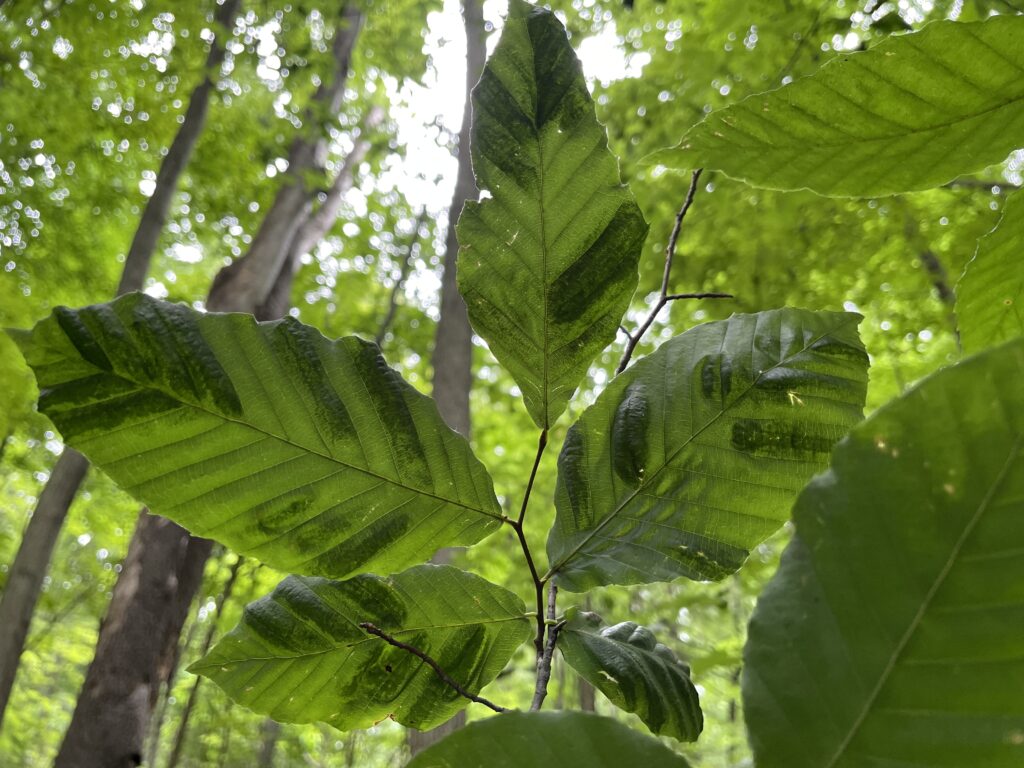

I was dismayed to learn about the beech bark and beech leaf diseases that are threatening these majestic trees. Below is a summary of a recent webinar from the EPA on the beech tree diseases.
Beech trees are “a pillar of the eastern forest ecosystem.” They are foundational trees, prized for their form, structure, dense shady canopy, smooth bark, and nuts. The American beech, Fagus grandifolia, is the twelfth most abundant tree in the United States. New York and New England have the highest densities. Commonly found in mixtures of maples and birch trees, beech trees are the most shade tolerant of any hardwood tree species, a characteristic which allows them to survive in the understory shade. Beech trees help birds and mammals such as bears, deer, and turkey grouse because their nuts have a high protein content. Unfortunately, there are two distinct threats to beech trees—beech bark disease and beech leaf disease.
The first, beech bark disease, has been in North America for more than 100 years. This disease arises from the interaction of a beech scale insect and fungal infection. The scale insect, a sap feeder that appears on the bark as a white, cottony secretion, produces small wounds on the bark that allow for the entry and infection by two fungal pathogens. Once established, the infection will induce cankering at the infection site. Fungal fruiting bodies may appear as small red dots in the cankers. Other signs of infection include loss of leaves and broken branches.
Beech bark disease does not kill trees right away, but once infected most trees weaken and die slowly over several years with older, larger trees appearing to be more susceptible. Once infected, the trees become more vulnerable to other fungi which can lead to a structural failure of the trunk called beech snap.
First discovered in Ohio in 2017, beech leaf disease has spread quickly and is now pervasive in forests near Lake Erie and in many locations in New York State. This disease is caused by a foliar nematode; vector transmission is unknown. Mild symptoms show normal-sized leaves but areas of discolored banding between the lateral veins. Heavier symptoms will show smaller leaves, curled up at the edges, some with a thick, leathery texture along with chlorosis and necrosis. Symptomatic leaves exhibit a fifty percent reduced rate of photosynthesis and the less efficient use of water, along with a significant deterioration of over and under story with canopy deterioration and branch die back. It can kill a mature tree in six to ten years and saplings in two years.
Control and treatment of these diseases is difficult and not practical in a forest setting. Treatment is a better option for urban landscape trees. No large-scale control methods exist. Ornamental beeches can be treated with insecticides (consult a certified arborist) to stop the scale that leads to beech bark disease. Using a soft brush or strong stream of water to remove the scale from the trunk may help. Horticultural oil can be applied to the trunk. Experts recommend basic good tree care to decrease the stress on the tree. This includes improving the soil, watering during dry periods, providing a large ring of mulch, and avoiding turfgrass competition. Sadly, even with such steps, the disease may advance and result in death. A small number of trees are resistant or show tolerance for the disease which provides hope for future breeding programs.
For beech leaf disease, treatment consists of best care practices noted above. Research is underway for reliable treatments. Some early research shows partial control with PolyPhosphite 30, a potassium fertilizer applied twice a year as a soil drench or soil injection that may help smaller trees. A fungicide foliar spray is also an option. Both treatments may produce symptom recovery and lower nematode population densities but do not kill all the nematodes. If interested in these treatments contact a DEC-certified pesticide applicator. Unfortunately, the widespread nature of the disease makes long-term management difficult. It’s anticipated the ongoing research will yield sustainable solutions for these diseases in the future.
REPORTING
The DEC states that the best way to report forest health problems, including the beech leaf disease is through nyimapinvasives.org.
Beth Mattimore is a freelance writer and Cornell Cooperative Extension Master Gardener from the Buffalo area.
Views: 15




